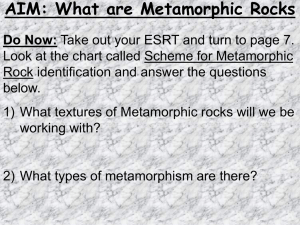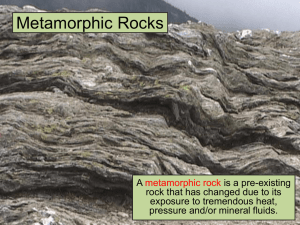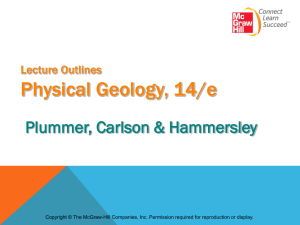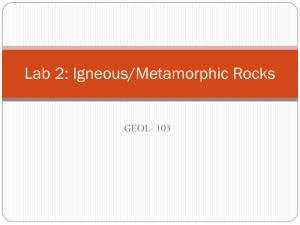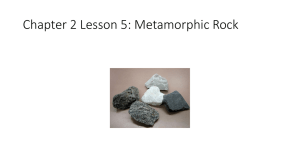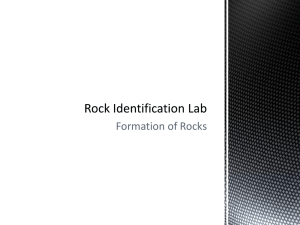3.4 Metamorphic Rocks Reading and Qs
advertisement
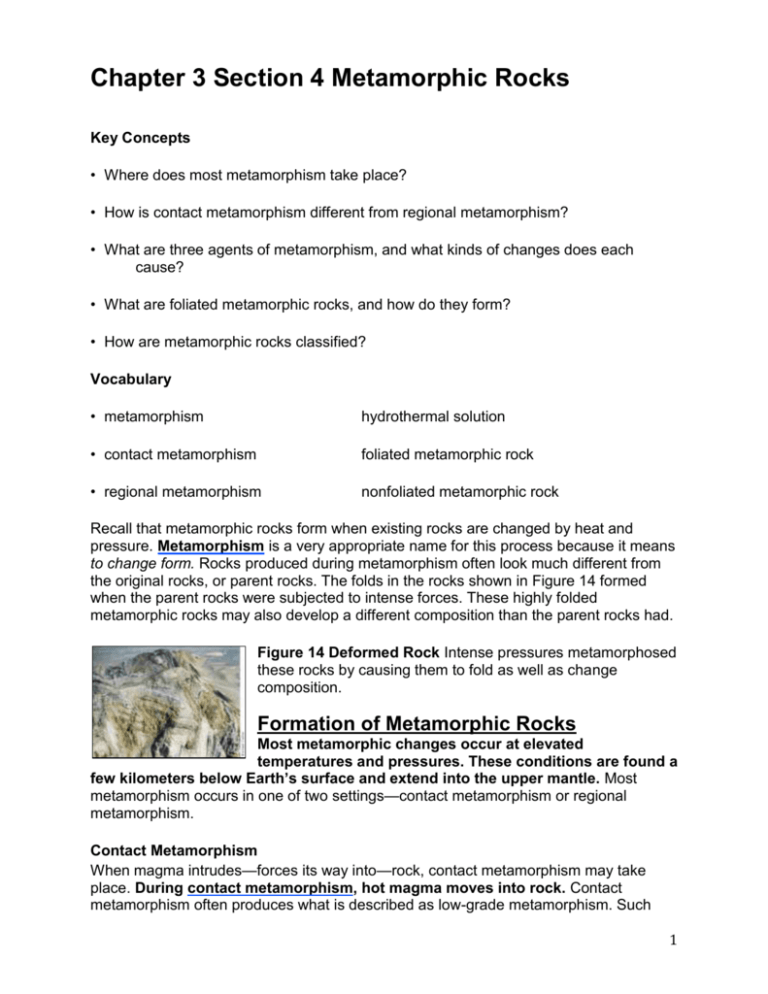
Chapter 3 Section 4 Metamorphic Rocks Key Concepts • Where does most metamorphism take place? • How is contact metamorphism different from regional metamorphism? • What are three agents of metamorphism, and what kinds of changes does each cause? • What are foliated metamorphic rocks, and how do they form? • How are metamorphic rocks classified? Vocabulary • metamorphism hydrothermal solution • contact metamorphism foliated metamorphic rock • regional metamorphism nonfoliated metamorphic rock Recall that metamorphic rocks form when existing rocks are changed by heat and pressure. Metamorphism is a very appropriate name for this process because it means to change form. Rocks produced during metamorphism often look much different from the original rocks, or parent rocks. The folds in the rocks shown in Figure 14 formed when the parent rocks were subjected to intense forces. These highly folded metamorphic rocks may also develop a different composition than the parent rocks had. Figure 14 Deformed Rock Intense pressures metamorphosed these rocks by causing them to fold as well as change composition. Formation of Metamorphic Rocks Most metamorphic changes occur at elevated temperatures and pressures. These conditions are found a few kilometers below Earth’s surface and extend into the upper mantle. Most metamorphism occurs in one of two settings—contact metamorphism or regional metamorphism. Contact Metamorphism When magma intrudes—forces its way into—rock, contact metamorphism may take place. During contact metamorphism, hot magma moves into rock. Contact metamorphism often produces what is described as low-grade metamorphism. Such 1 changes in rocks are minor. Marble, like that used to make the statue in Figure 15, is a common contact metamorphic rock. Marble often forms when magma intrudes a limestone body. Figure 15 Statue Carved from Marble Marble is a common metamorphic rock that forms as the result of contact metamorphism of limestone. Regional Metamorphism During mountain building, large areas of rocks are subjected to extreme pressures and temperatures. The intense changes produced during this process are described as highgrade metamorphism. Regional metamorphism results in large-scale deformation and high-grade metamorphism. The rocks shown in Figure 14 on page 80 were changed as the result of regional metamorphism. Agents of Metamorphism The agents of metamorphism are heat, pressure, and hydrothermal solutions. During metamorphism, rocks are usually subjected to all three of these agents at the same time. However, the effect of each agent varies greatly from one situation to another. Heat The most important agent of metamorphism is heat. Heat provides the energy needed to drive chemical reactions. Some of these reactions cause existing minerals to recrystallize. Other reactions cause new minerals to form. The heat for metamorphism comes mainly from two sources—magma and the change in temperature with depth. Magma essentially “bakes” any rocks that are in contact with it. Heat also comes from the gradual increase in temperature with depth. In the upper crust, this increase averages between 20°C and 30°C per kilometer. When buried to a depth of about 8 kilometers, clay minerals are exposed to temperatures of 150°C to 200°C. These minerals become unstable and recrystallize to form new minerals that are stable at these temperatures, such as chlorite and muscovite. In contrast, silicate minerals are stable at these temperatures. Therefore, it takes higher temperatures to change silicate minerals. Q How hot is it deep in the crust? A The deeper a person goes beneath Earth’s surface, the hotter it gets. The deepest mine in the world is the Western Deep Levels mine in South Africa, which is about 4 kilometers deep. Here, the temperature of the surrounding rock is so hot that it can scorch human skin. In fact, miners in this mine often work in groups of two. One miner mines the rock, and the other operates a large fan that keeps the worker cool. 2 Pressure (Stress) Pressure, like temperature, also increases with depth. Like the water pressure you might have experienced at the bottom of a swimming pool, pressure on rocks within Earth is applied in all directions. See Figure 16. Pressure on rocks causes the spaces between mineral grains to close. The result is a more compact rock with a greater density. This pressure also may cause minerals to recrystallize into new minerals. Figure 16 Pressure (Stress) As a Metamorphic Agent A Forces in all directions are applied equally to buried rocks. B During mountain building, rocks subjected to differential stress are shortened in the direction that pressure is applied. Increases in temperature and pressure cause rocks to flow rather than fracture. Under these conditions, mineral grains tend to flatten and elongate. During mountain building, horizontal forces metamorphose large segments of Earth’s crust. This often produces intricately folded rocks like those shown in Figure 17. Figure 17 Imagine the tremendous amounts of pressure that caused these rocks to fold. Reactions in Solution Water solutions containing other substances that readily change to gases at the surface play an important role in some types of metamorphism. Solutions that surround 3 mineral grains aid in recrystallization by making it easier for ions to move. When solutions increase in temperature reactions among substances can occur at a faster rate. When these hot, water-based solutions escape from a mass of magma, they are called hydrothermal solutions. These hot fluids also promote recrystallization by dissolving original minerals and then depositing new ones. As a result of contact with hydrothermal solutions, a change in a rock’s overall composition may occur. Classification of Metamorphic Rocks Like igneous rocks, metamorphic rocks can be classified by texture and composition. The texture of metamorphic rocks can be foliated or nonfoliated. Foliated Metamorphic Rocks When rocks undergo contact metamorphism, they become more compact and thus more dense. A common example is the metamorphic rock slate. Slate forms when shale is subjected to temperatures and pressures only slightly greater than those at which the shale formed. The pressure on the shale causes the microscopic clay minerals to become more compact. The increase in pressure also causes the clay minerals to align in a similar direction. Under more extreme conditions, certain minerals will recrystallize. Some minerals recrystallize with a preferred orientation, which is at right angles to the direction of the force. The resulting alignment usually gives the rock a layered or banded appearance. This rock is called a foliated metamorphic rock. Gneiss, the metamorphic rock shown in Figure 18, is a foliated rock. Another foliated metamorphic rock is schist. Figure 18 Gneiss is a foliated metamorphic rock. Inferring: In which directions was pressure exerted on this rock? Nonfoliated Metamorphic Rocks A metamorphic rock that does not have a banded texture is called a nonfoliated metamorphic rock. Most nonfoliated rocks contain only one mineral. Marble, for example, is a nonfoliated rock made of calcite. When its parent rock, limestone, is metamorphosed, the calcite crystals combine to form the larger interlocking crystals seen in marble. A sample of marble is shown in Figure 19. Quartzite and anthracite are other nonfoliated metamorphic rocks. Figure 19 Marble is a nonfoliated metamorphic rock. To summarize, metamorphic rocks form when existing rocks are changed by heat, pressure, or hydrothermal solution. Contact metamorphism is often caused when hot magma intrudes a body of rock. Changes during this type of metamorphism are minor. Regional metamorphism is associated with mountain building. Such metamorphic changes can be extreme. Metamorphic rocks can be classified by texture as foliated or nonfoliated, as shown in Table 3. 4 SECTION 3.4 Assessment Please answer all questions on lined paper and in complete sentences! Reviewing Concepts (1)Where does most metamorphism take place? (2)Compare and contrast contact metamorphism and regional metamorphism? (3)Name the agents of metamorphism and explain how each changes a rock. (4)What are foliated rocks, and how do they form? (5)How are metamorphic rocks classified? Critical Thinking (6) Applying Concepts What is the major difference between igneous and metamorphic rocks? (7) Predicting What type of metamorphism—contact or regional—would result in a schist? Explain your choice. SECTION 3.4 Assessment Please answer all questions on lined paper and in complete sentences! Reviewing Concepts (1)Where does most metamorphism take place? (2)Compare and contrast contact metamorphism and regional metamorphism? (3)Name the agents of metamorphism and explain how each changes a rock. (4)What are foliated rocks, and how do they form? (5)How are metamorphic rocks classified? Critical Thinking (6) Applying Concepts What is the major difference between igneous and metamorphic rocks? (7) Predicting What type of metamorphism—contact or regional—would result in a schist? Explain your choice. 5

